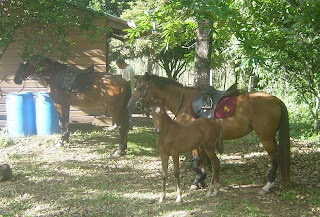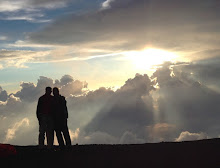Something happened in our community here in the beginning of July which was very significant to many people here, including us, but which we elected not to blog about at the time out of respect for the victims and their families, and because we just needed some time to think about it. A month and a half later we’ve come to the conclusion that a lot of people read this blog to see how American expats cope with life in Belize, and since this incident has made us do a lot of things differently than we did before it happened, we thought we should at least mention it.
The incident was the murder of an American expat couple in Cristo Rey, which is the town between San Antonio and Santa Elena. The couple had lived in Belize for close to twenty years, and they were universally respected and liked by both locals and expats. The wife was an excellent, well respected real estate agent. Tom and I had looked at a few houses with her and were very impressed. Her husband was working on creating a subdivision on some land they owned on the river, and employed a number of area people on that job. They were both active in area charities and in the humane society, and would take the time to help anyone they felt needed help. Donna actually taught Tom and I how to deal with beggars here. We had stopped at the Belmopan market for lunch, and a woman was begging for money for food for her children. Donna didn’t give her money, but she went to one of the market booths and bought the woman a bag of rice and a bag of beans. It seems simple, but Tom and I now take the same approach with beggars, and it’s amazing what a difference it makes in how you feel about helping when you know your money isn’t going for drugs or alcohol instead of food. And Tom and I were not the only ones in Belize who learned such valuable lessons from Donna.
On the first Saturday in July, the 15-year-old stepson of one of their employees decided that he wanted some of their things and some of their money, so he and a 17-year-old friend went to their home to rob them. The boys said that after they had taken a number of high-ticket items and a lot of cash they realized they had to kill the couple because they knew who they were. They were arrested and confessed a few days later, but the couple was already dead.
I was with my family in Vermont when Tom told me about what happened. He told me he understood if I elected not to come home, and that we could figure out whether or not we wanted to continue living in Belize. The horror was put in some perspective by friends and family in the US, where my brother told me a 12-year-old girl had been abducted, raped, and murdered less than 20 miles from his house in rural Vermont the previous week. I also found that some gentle and peace-loving friends now carry concealed pistols to protect themselves in various places they routinely go in their day-to-day lives. So, while we were still shocked, horrified, and saddened by what had happened in Belize, we realized that while Belize may not be better than other places we’ve lived as far as safety goes, it’s probably not any worse. We aren’t living in any state of worry or fear, we are just being more careful than we were when we first arrived.
To reduce the risk to us, we’ve made a few changes to how we do things here, and it’s been difficult. These people were killed basically because somebody wanted their things and their money, and it’s assumed here that all gringos have things and money, so all gringos are at risk. This isn’t to say that Belizeans don’t commit violence against fellow Belizeans, because the majority of violent crimes are Belizean to Belizean. However, the more we can minimize the visibility of our money and our things, the more we can minimize our personal risk.
So, we no longer allow people to borrow anything of any significant value. This has been an uncomfortable situation with us for a while, because we’ve learned that the Belizean borrowing ethic is a little different from what we were used to in the US. This isn’t just Belizeans borrowing from gringos; it also applies when Belizeans borrow from Belizeans, or if gringos borrow from Belizeans. First, people will ask to borrow almost anything, even things that we would never have considered asking anyone for in the US, and some of these things are things we just weren’t comfortable loaning to other people, such as our truck. We’ve had to learn to say no, because another thing with the borrowing ethic here is that the attitude is that if you’ve borrowed something, it’s yours, and you can do whatever you would do with it if it was actually yours – including letting other people use it, giving it away, trading it in for a new model (but then keeping the new model because, after all, you bought it – true story with a neighbor’s borrowed generator), using up all the consumables (like fuel and weed whacker string), taking it apart to see how it works, etc. The other thing is that very few things are returned until the owner asks, when the borrower usually says, “Oh, I didn’t know you needed it,” and people like me have to bite their tongues to avoid saying “Why do you think I have it if I don’t need it???” This little detail is further complicated because sometimes the borrowed item has been loaned to a third, fourth, or fifth party whom the owner doesn’t even know, so it gets difficult to track an item down to ask for it back when you don’t know where it is. This also happens sometimes because an item is borrowed without asking the owner. People will get all sorts of offended when you ask why they took your stuff without your permission, and they just say that since you weren't using it at the time, what’s the harm in borrowing? It’s not stealing, but it also puts the owner in a difficult position when something has been borrowed and the owner doesn’t even know who borrowed it so he can ask for it to be returned, because it won’t be returned until the owner asks.
Prior to the murders, we’d put the brakes on some of our things being borrowed because of this borrowing ethic, but after the murders we realized that by being generous and allowing some of our big-ticket items – weed whacker, camera, hair clippers, horse tack, appliances, power tools, etc. – to be borrowed, we were basically flashing our stuff to anyone who wanted to see it. We don’t know who the borrowers associate with on a day to day basis, and who might see something of ours that they’d like to have, so now we’re just saying no. Laid out like this it probably sounds easy and obvious, but we feel somewhat that we’re punishing our Belizean friends because of something a couple of truly evil people did. However, there are nothing close to seven degrees of separation in Belize – it’s probably more like two – so we are taking the advice and not letting anything of any value off the property where it may be seen.
The other big change we’ve made is that we’re no longer the bus when we head out of the Mountain Pine Ridge and in to San Ignacio or Spanish Lookout. Too many people have warned us that you never know who you pick up or what they may see in your truck, so we’re not picking up anybody unless we really know them, and then only if they’re alone. If someone we know is in a group of people, we drive right on by. This is difficult, especially since we’ve met lots of people giving them rides, and many people hear our truck coming and stand up figuring we’ll stop, and now we don’t stop. What makes us even sadder is that many people now seem to understand. I drove by a group of men on the way to Spanish Lookout a couple of weeks ago, and they all stood up and waved. I sort of cringed and shrugged, and they all waved me by and smiled, thinking, no doubt, that they wouldn’t want their wives, mothers, girlfriends, or sisters to pick up a group of hitch hiking men.
What also makes us sad, besides the fact that the lives of two good people were wasted, is that many Belizeans we talk to seem to feel guilty about the crime because they see that it was based on the idea that gringos have what Belizeans want. Most of these people would never consider, at their worst moments, doing anything bad to any other living thing, but they still feel bad and apologize (even 10 year old Wilton apologized), and talk to us about what we need to do to make ourselves safer. Then we compound the problem, at their recommendation, by no longer sharing our things or giving rides, which makes us feel bad. Everybody feels bad, sad, and uncomfortable, and there’s no telling how long it will take before this rift starts to heal.
 They finished the jobio table a few weeks ago, and that’s now on our deck. We put the plain sapodilla table on one of the porches in the guest cabin, and this prickly yellow and sapodilla table on the other porch.
They finished the jobio table a few weeks ago, and that’s now on our deck. We put the plain sapodilla table on one of the porches in the guest cabin, and this prickly yellow and sapodilla table on the other porch.

























